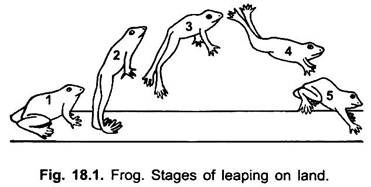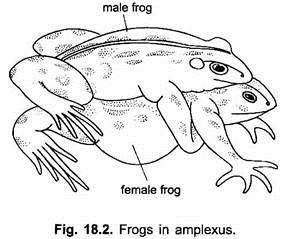Rana tigrina, the common Indian bull frog, generally lives in or near water but in rains it may be found far away from its natural habitat, the aquatic home. It lives near water probably- (i) to carry out the cutaneous respiration by keeping the skin moist as soon as it gets dry and (ii) to escape from the man and a number of other enemies by slipping or jumping into the water. During the breeding season frogs are more closely confined to the water than other times of the year.
Frogs are harmless, non-poisonous and quick-moving active animals. It rests on land by keeping its short angular forelimbs upright and the long hindlimbs folded by the side of the body; when disturbed; it jumps into water by suddenly extending its hindlimbs in order to escape.
1. Locomotion:
Frogs move by leaping and swimming, and in both of these operations the long hindlegs play the chief part.
ADVERTISEMENTS:
2. Feeding:
It is carnivorous in its feeding habit and feeds on small insects, spiders and earthworms which are caught by throwing out the extensible sticky mucous-coated tongue from the mouth and swallowed entire organisms. The tongue is attached anteriorly, while the forked posterior end lies free. It always rejects motionless animals and undesirable food.
(i) Leaping:
In the ordinary resting position the body is inclined upward in front, being supported on the forelegs and its thumb points nearly backward. The posterior part of the body rests upon the ground and the hindlimbs are folded up ready for a spring.
ADVERTISEMENTS:
By sudden extension of the hindlegs the body is propelled through the air. In leaping, the forelimbs are used more to hold up the anterior part of the body and to point the animal in the desired direction of movement than as actual organs for propulsion. It may leap from 2 to 3 feet.
(ii) Swimming:
In both operations the hindlegs are alternately drawn up in the form of a “Z” and quickly extended. As the hindlegs are pushed back during swimming, the toes are spread apart, the webs between them affords resistance to passing through the water.
This motion gives the body a forward impulse. The forelimbs are also used in swimming, taking strokes sometimes together and sometimes alternately. When the animal swims downward, the forelegs beat backward and upward.
ADVERTISEMENTS:
When it swims upward, forelegs beat downward elevating the anterior part of the body, which is then pushed upward by the strokes of the hindlegs. When frog comes to surface to breathe or simply to float, only the tip of the nose remains exposed. The hindlegs hang obliquely in a state of moderate extension and the forelegs are held out from the body.
3. Croaking Sound:
The sound produced by the frog is called the croaking. It is more often heard during the breeding season (rainy season), when they are supposed to serve the purpose of a sex call. The sound of male is louder and deeper than that of the female.
In large frogs the voice are deeper than in small ones. Frogs croak under water as well as on land. It is produced by forcing the air from the lungs over vocal cords into the mouth, the external nares remain closed to prevent its escape. Then the buccal cavity contracts, forcing the air back into the lungs again. The same process is repeated again and again.
4. Seasonal Changes:
It is cold-blooded or poikilothermal or ectothermal animal as its body temperature does not remain constant but fluctuates with that of environment. In winter the temperature of the body becomes so much low that its all body activities get ceased down and it becomes sluggish.
In this condition it cannot live more on the land, so it digs down into damp earth at the bottom of ponds to pass the adverse conditions of winter and rest. This going of underground is known as winter sleep or hibernation. During winter sleep or hibernation lung breathing is stopped, while skin breathing continues which suffice the need of the oxygen. Moreover it does not feed but to keep up its vital activities it consumes the reserve food stored in the form of glycogen and fat.
It remains underground till the rain falls. Similarly during the summer it once again goes underground to sleep as its all body activities are slowed down due to high temperature. This going of underground is known as summer sleep or aestivation. The spring and rainy seasons are the periods of great activity for the frogs.
5. Colour Changes:
ADVERTISEMENTS:
Frogs have the power of changing their colour in harmony with their surroundings to protect from enemies. The power of the skin to change its colour in relation to surrounding conditions depends upon changes in chromatophores (pigment cells). The colour change of the skin depends upon the difference in the distribution of pigments (black and yellow). When the pigment of black chromatophores is expanded, the skin becomes dark in colour and when it becomes contracted, the skin becomes light coloured.
6. Breeding:
In mating or copulation the male clasps the female by its forelegs from its back just behind her forelegs. The nuptial pads on the bases of inner fingers of male also help in firmly clasping the female. This sexual embrace is called amplexus which continues for several days until the female deposits the eggs through cloaca in water.
The male also discharges his spermatic fluid over them to fertilise. The male then loses his clasping instinct and is totally indifferent to the other sex. Egg’s mass called frogs spawn is formed by adhering the jelly surrounding the eggs. The jelly of the eggs absorbs water and swells and adheres with each other. The fertilised eggs (zygotes) develop into free-swimming tadpole within a fortnight and then undergo metamorphosis to become miniature adult.
7. Enemies:
Frogs are the most defenceless animals and fall easy prey to a variety of carnivorous animals, who devour them in great numbers. These animals are snakes, turtles, mongooses, racoons, cranes, herons, hawks and crows. Man is also their enemy who is very fond of their legs.
The frog is also afflicted by a large number of parasitic forms, such as leeches remain attached to frog for a long period, larvae of blowflies infest the intestine of frogs, but usually in great numbers in toads. Nematodes such as round worms are found in the intestine of frogs.
Trematodes or flukes are also found in the intestine and bladder, and sometimes in lungs are also found. Among protozoans are Opalina, Balantidium, Copromonas found in rectum; Entamoeba found in the intestine; Eimeria infest intestinal epithelum; Isospora spp. in the cells of kidneys.
8. Economic Importance:
Frog has remained a favourite object for the study of animal structure and function since a long time. It is very commonly used in the physiological researches. It is due to its easy availability. It is also widely used in instruction, since its structure is more or less similar to that of the human body. It is a good friend of farmers because it feeds on insects harmful to crops. Its muscular hindlegs are eaten in China and so they are reared in ponds, etc.
The frogs, generally, breed in the rainy season, appearing with the first shower. As soon as the rains fall the frogs come out from their hidden places (hibernation and aestivation) and start croaking. Male frogs, by croaking, attract the female frogs for breeding or copulation.
Frogs, generally, seek shallow quiet water as a breeding place where they lay down their eggs for fertilisation. The parents never pay any attention to them but lead a carefree life of excessive feeding. The eggs develop into embryos that hatch out as tadpoles or larvae in about two weeks.
There are so many natural enemies of frog such as snakes, turtles, herons, raccoons and man. To escape from these enemies frog tries to jump into water or conceal itself in the bottom of debris or green vegetation as its body colour coincides with that of environment.

